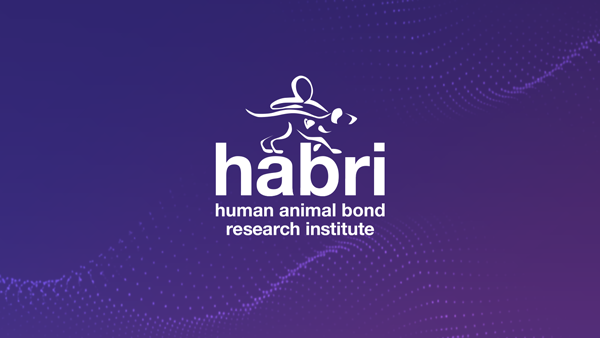May is Mental Health Month. According to HABRI’s survey of pet owners, the majority of pet owners have personal experience with the health benefits of pets:
- 74% of pet owners reported mental health improvements from pet ownership
- 75% of pet owners reported a friend’s or family member’s mental health has improved from pet ownership
The scientific research that supports the human-animal bond – or the mutually beneficial relationship between people and pets – for better mental health indicates that pets can make a difference for those facing mental health concerns, including anxiety, depression, loneliness and stress.
HABRI, in partnership with Mental Health America, has created this new infographic highlighting the mental health benefits of a healthy relationship with a pet.
HABRI hopes that in sharing this far and wide throughout Mental Health Month, we can encourage people to take care of their pets and remind them that in good times and in bad, our companion animals can be wonderful sources of support and relief from mental health conditions.
Please consider posting this infographic on your social media channels, websites and with your colleagues, friends and family to help us strengthen the human-animal bond for all!
References
- Allen, K., Blascovich, J., & Mendes, W. B. (2002). Cardiovascular reactivity and the presence of pets, friends, and spouses: The truth about cats and dogs. Psychosomatic medicine, 64(5), 727-739.
- Brooks, H., Rushton, K., Walker, S., Lovell, K., & Rogers, A. (2016). Ontological security and connectivity provided by pets: a study in the self-management of the everyday lives of people diagnosed with a long-term mental health condition. BMC psychiatry, 16(1), 409.
- Valeri, R. M. (2006). Tails of laughter: A pilot study examining the relationship between companion animal guardianship (pet ownership) and laughter. Society & Animals, 14(3), 275-293.
- HABRI, Social Isolation & Loneliness
- Hui Gan, G. Z., Hill, A. M., Yeung, P., Keesing, S., & Netto, J. A. (2020). Pet ownership and its influence on mental health in older adults. Aging & mental health, 24(10), 1605-1612.
- McConnell, A. R., Brown, C. M., Shoda, T. M., Stayton, L. E., & Martin, C. E. (2011). Friends with benefits: on the positive consequences of pet ownership. Journal of personality and social psychology, 101(6), 1239.
- Goldmeier, J. (1986). Pets or people: Another research note. The Gerontologist, 26(2), 203-206.
- Zasloff, R. L., & Kidd, A. H. (1994). Loneliness and pet ownership among single women. Psychological Reports, 75(2), 747-752.
- Bao, K. J., & Schreer, G. (2016). Pets and happiness: Examining the association between pet ownership and wellbeing. Anthrozoös, 29(2), 283-296.
- McConnell, A. R., Brown, C. M., Shoda, T. M., Stayton, L. E., & Martin, C. E. (2011). Friends with benefits: on the positive consequences of pet ownership. Journal of personality and social psychology, 101(6), 1239.
- Hawkins, R. D., & Williams, J. M. (2017). Childhood attachment to pets: Associations between pet attachment, attitudes to animals, compassion, and humane behaviour. International journal of environmental research and public health, 14(5), 490.
- Brooks, H., Rushton, K., Walker, S., Lovell, K., & Rogers, A. (2016). Ontological security and connectivity provided by pets: a study in the self-management of the everyday lives of people diagnosed with a long-term mental health condition. BMC psychiatry, 16(1), 409.
- Beetz, A., Uvnäs-Moberg, K., Julius, H., & Kotrschal, K. (2012). Psychosocial and psychophysiological effects of human-animal interactions: the possible role of oxytocin. Frontiers in psychology, 3, 234.
- Miller, S. C., Kennedy, C. C., DeVoe, D. C., Hickey, M., Nelson, T., & Kogan, L. (2009). An examination of changes in oxytocin levels in men and women before and after interaction with a bonded dog. Anthrozoös, 22(1), 31-42.
- Odendaal, J. S. (2000). Animal-assisted therapy—magic or medicine?. Journal of psychosomatic research, 49(4), 275-280.
- Odendaal, J. S., & Meintjes, R. A. (2003). Neurophysiological correlates of affiliative behaviour between humans and dogs. The Veterinary Journal, 165(3), 296-301.
- Pop, D. A., Rusu, A. S., Pop-Vancea, V., Papuc, I., Constantinescu, R., & Miresan, V. (2014). Physiological effects of human-animal positive interaction in dogs-review of the literature. Bulletin of University of Agricultural Sciences and Veterinary Medicine Cluj-Napoca. Animal Science and Biotechnologies, 71(2), 102-110.
- Nagasawa, M., Mitsui, S., En, S., Ohtani, N., Ohta, M., Sakuma, Y., … & Kikusui, T. (2015). Oxytocin-gaze positive loop and the coevolution of human-dog bonds. Science, 348(6232), 333-336.
- Vitale, K. R., Behnke, A. C., & Udell, M. A. (2019). Attachment bonds between domestic cats and humans. Current Biology, 29(18), R864-R865.
- Shreve, K. R. V., Mehrkam, L. R., & Udell, M. A. (2017). Social interaction, food, scent or toys? A formal assessment of domestic pet and shelter cat (Felis silvestris catus) preferences. Behavioural Processes, 141, 322-328.






